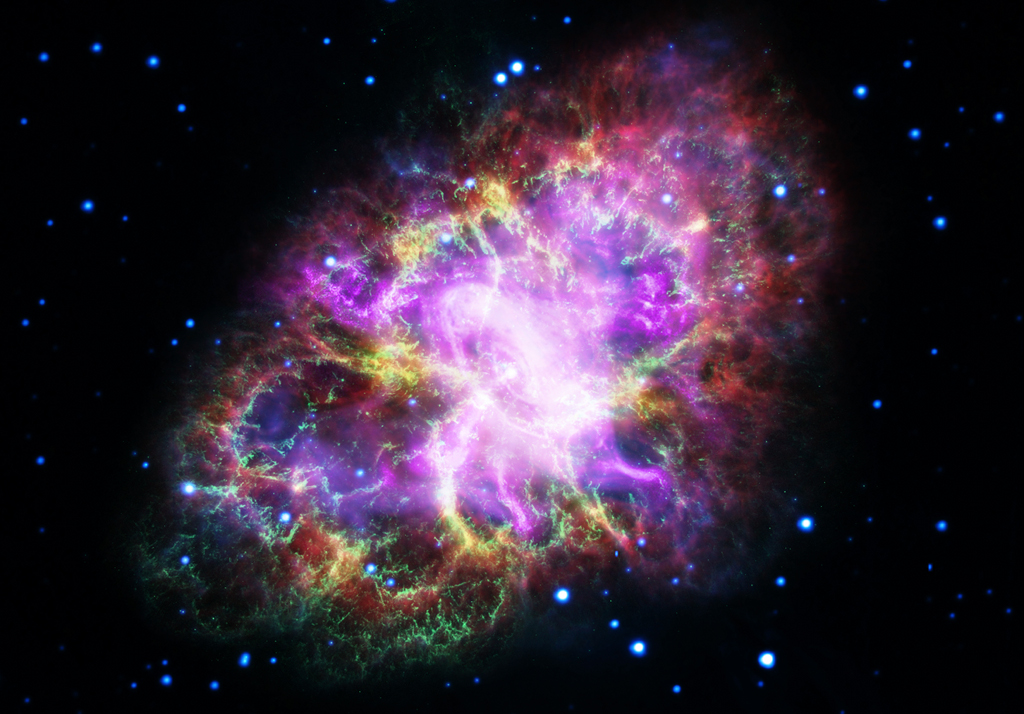2022年3月5日
The Multiwavelength Crab
Image Credit & Copyright: NASA, ESA, G. Dubner (IAFE, CONICET-University of Buenos Aires) et al.;
A. Loll et al.; T. Temim et al.; F. Seward et al.; VLA/NRAO/AUI/NSF; Chandra/CXC;
Spitzer/JPL-Caltech; XMM-Newton/ESA; Hubble/STScI
Explanation: The Crab Nebula is cataloged as M1, the first object on Charles Messier’s famous list of things which are not comets. In fact, the Crab is now known to be a supernova remnant, expanding debris from massive star’s death explosion, witnessed on planet Earth in 1054 AD. This brave new image offers a 21st century view of the Crab Nebula by presenting image data from across the electromagnetic spectrum as wavelengths of visible light. From space, Chandra (X-ray) XMM-Newton (ultraviolet), Hubble (visible), and Spitzer (infrared), data are in purple, blue, green, and yellow hues. From the ground, Very Large Array radio wavelength data is shown in red. One of the most exotic objects known to modern astronomers, the Crab Pulsar, a neutron star spinning 30 times a second, is the bright spot near picture center. Like a cosmic dynamo, this collapsed remnant of the stellar core powers the Crab’s emission across the electromagnetic spectrum. Spanning about 12 light-years, the Crab Nebula is 6,500 light-years away in the constellation Taurus.
Tomorrow’s picture: from somewhere else
蟹状星云的多波段影像
影像提供:NASA, ESA, G. Dubner (IAFE, CONICET-University of Buenos Aires) et al.;
A. Loll et al.; T. Temim et al.; F. Seward et al.; VLA/NRAO/AUI/NSF; Chandra/CXC;
Spitzer/JPL-Caltech; XMM-Newton/ESA; Hubble/STScI
说明: 在18世纪著名的查尔斯·梅西耶”非彗星”星表里,蟹状星云的编号是M1。我们现在知道蟹状星云实际上是个超新星遗迹,是一颗大质量恒星在西元1054年发生死亡爆炸后,所留下来的扩张碎片云。上面这幅全新的21世纪蟹状星云影像,整合了横跨数个电磁波段之影像数据,并以不同色泽的可见光加以显示。其中摄于太空的钱德拉(X射线)、XMM-Newton(紫外光)、哈伯(可见光)、和史匹哲(红外光)数据,分别以紫、蓝、绿、及黄色来呈现。来自地面的极大阵列的电波数据,则以红色来呈现。影像中心的亮斑即为蟹状星云波霎,它是颗每秒自转30次的中子星,也是现代天文学家所知最奇特的天体之一。就如同一部宇宙级的发电机,这个恒星核驱动星云在所有电磁波段发出辐射。跨幅约为12光年的蟹状星云,位在金牛座内,离我们只有6,500光年远。
明日的图片: from somewhere else







